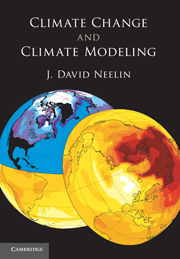Book contents
- Frontmatter
- Contents
- Preface
- 1 Overview of climate variability and climate science
- 2 Basics of global climate
- 3 Physical processes in the climate system
- 4 El Niño and year-to-year climate prediction
- 5 Climate models
- 6 The greenhouse effect and climate feedbacks
- 7 Climate model scenarios for global warming
- Glossary
- References
- Index
7 - Climate model scenarios for global warming
Published online by Cambridge University Press: 05 June 2012
- Frontmatter
- Contents
- Preface
- 1 Overview of climate variability and climate science
- 2 Basics of global climate
- 3 Physical processes in the climate system
- 4 El Niño and year-to-year climate prediction
- 5 Climate models
- 6 The greenhouse effect and climate feedbacks
- 7 Climate model scenarios for global warming
- Glossary
- References
- Index
Summary
Greenhouse gases, aerosols and other climate forcings
Scenarios, forcings and feedbacks
Climate model predictions for global warming differ from predictions for ENSO because the system is responding to a forcing that is being continuously applied, namely the radiative effects of greenhouse gases (GHG) in the atmosphere. The term driver of climate change is sometimes now used for communicating to the public, but forcing is the standard scientific term. In Chapter 6, we saw that the top-of-atmosphere radiative imbalance caused by GHG provided a useful measure of the radiative forcing to which the climate system responds. In a forced system, in principle, if we know how the forcing behaves as a function of time we can obtain the system response. In the climate system, there is always chaotic natural variability about the forced response but if there is an ongoing forcing that tends to warm the climate, then the variations will occur about the forced warmer state. This is why, if the forcing were known, climate model predictions could be made a century ahead and have some meaning, whereas even the most perfect ENSO prediction system would have no skill after a couple of years.
Future GHG emissions are, of course, not actually known at this time. Instead climate researchers collaborate with economists and social scientists to construct possible scenarios of future emissions and the resulting concentrations. These scenarios may be quite complex attempts to project energy demand and population growth, taking into account assumptions such as a possible phase-out of nuclear energy or improvements in solar technology.
- Type
- Chapter
- Information
- Climate Change and Climate Modeling , pp. 221 - 262Publisher: Cambridge University PressPrint publication year: 2010



